About Orson Welles director's later works and his career, traditionally the younger generation of "millennials" (broadly referring to those born in 1984-95) or even younger latecomers seem to know little about it, until events such as "The Trial" ”, “Midnight Clock”, “The Fake” and other films in digital high-definition remake, show and distribute, so that more people have the opportunity to re-understand this giant and genius who can be regarded as the first giant in the history of film, and along with it. On the other hand, there are more movie mysteries that have not been or may never be solved, such as many great projects that Orson Welles has not really completed or come out with until his death: "Don Quixote", "Dream" Home", "The Abyss"...and so on, and the most eye-catching, the largest, and the most important to Orson Welles is the long-lost legendary "The Other Side of the Wind".
After Wells' death, "The Other Side of the Wind" entered into a lengthy and complex so-called copyright dispute that made the already extremely complex post-production work even more difficult. Entering the 21st century, after even attempts to finalize and distribute the film through online crowdfunding have failed, Netflix, as a tycoon of emerging streaming media and online film and television distribution, helped buy the film's copyright in one fell swoop. and distribution rights, so that the long-ago rare treasure finally resurfaced. Interestingly, all of the above facts seem to reflect the arrival of a possible new movie future - the popularity of streaming media in the era of digital high-definition video has attracted the attention of a large number of "millennials" and teenagers, and has become a huge part of them. As an important or even preferred channel for understanding and obtaining high-quality video viewing resources, a film production-distribution-exhibition platform that is far more convenient, flexible, cheaper and more popular than traditional big studios and their systems has been formed even when it is about to appear. It is a strong challenge to the former, and is even considered to be a serious threat by many vested interests in the so-called industry circle. The most typical example is that many Netflix-invested films (including "The Other Side of the Wind" and this year's Venice Golden Lion Award-winning film "Roma", etc.) that were supposed to be publicly screened during this year's Cannes Film Festival did not comply with the French copyright. Regulations have to be forced to withdraw.
And when we look back on Orson Welles' late career and even his entire life, it is not difficult to find that this lonely giant has been working with film copyright owners and so-called vested interests for decades to complete the creation of the works Fighting for power is like repeatedly projecting the characters and plots in his works: Kane, who has everything but only obsessed with "rosebuds", Professor Rankin, who is submissive on the surface but turbulent in his heart, and who is unrestrained in the face of wealth and sex. Michael, who lost himself, and those Wells who have always been devoted to famous classics and the tragic images of fate in the various spiritual shackles under their influence: Macbeth, Othello, Mr. Arkadine... and so on. It is not surprising that Orson Welles, who has been portrayed as a "narcissistic" film innovator in the profit-oriented Hollywood for many years, is not regarded by the mainstream, but the key problem is not that the so-called "film author" ” or how the “author’s film” survives in the industry; nor is it arguing whether today’s view of film or film art should be in the same line as the history of film that has passed more than a hundred years; Where is such an empty assumption, but in the context of today's unique and rapid global media dissemination, how should the younger generation and latecomers innovate and give new life to film and film art.
We can't expect that even today, when conditions are more convenient for all parties and the threshold for video is greatly reduced, more geniuses like Wells can be born. This reminds me of the last part of the film "The Other Side of the Wind". John Dyer, who plays the young male star in his film, faces old director Jack Hannaford's call for a hitchhiker in the early morning behind the chicken feathers. The blank eyes and facial close-up are full of symbolism. Doesn't it also seem to express the fault and generation gap between today's film industry and film history? The repeated use of crystal images of characters and words in the whole film, the frequent appearances of many cameras in a highly anthropomorphic style, the insertion of students, reporters, film critics, young film practitioners and even dummies, etc., make Ben so wonderful. The film in the film is reversed, set aside, ignored, and misinterpreted as if placed in a kaleidoscope of complicated glass mirrors. It sends the image back. But the mirrors reflect so much light...they turn things upside down."
We, who have not read much deconstructionism, are deconstructing our artistic heritage today in the name of the capitalist market economy as if we were splitting up the new capitalist market, and we seem to be getting more and more accustomed to putting our legacy within our grasp. The symbols are digested whole and reassembled by self-righteous laws like a baby playing with building blocks. Except for the use of materials, the meaning of existence of artistic heritage almost no longer exists, which once again touched the cake of those copyright owners and vested interests that have been formed for a long time. While they occupied the commanding heights of law and morality early, they greatly restricted the wide dissemination and inheritance of a large number of artistic heritages on the grounds that "the light reflected by the mirror cannot reverse the true nature", making the later generations who were faced with the eradication even more hopeless. feared. A new revolution is about to emerge.
However, this potential new revolution in film has nothing to do with the so-called technological innovation of imaging or the illusory "hope" of the new generation. In the final analysis, it originates from the eternal development of the film itself, which is "new and new". The examples of yesterday's glorious names and powers under the guise of film and film art, and finally involuntarily declined because of the conservative vested interests have been played out many times in the history of film and will continue to be played out, and Robert Bresson said : "Having experienced one kind of art and carrying its imprint, one cannot enter another art again"; "The future of film writing belongs to those lonely young people who despise all the stereotypes in the industry."
self-determination
2018.12.26
View more about The Other Side of the Wind reviews











